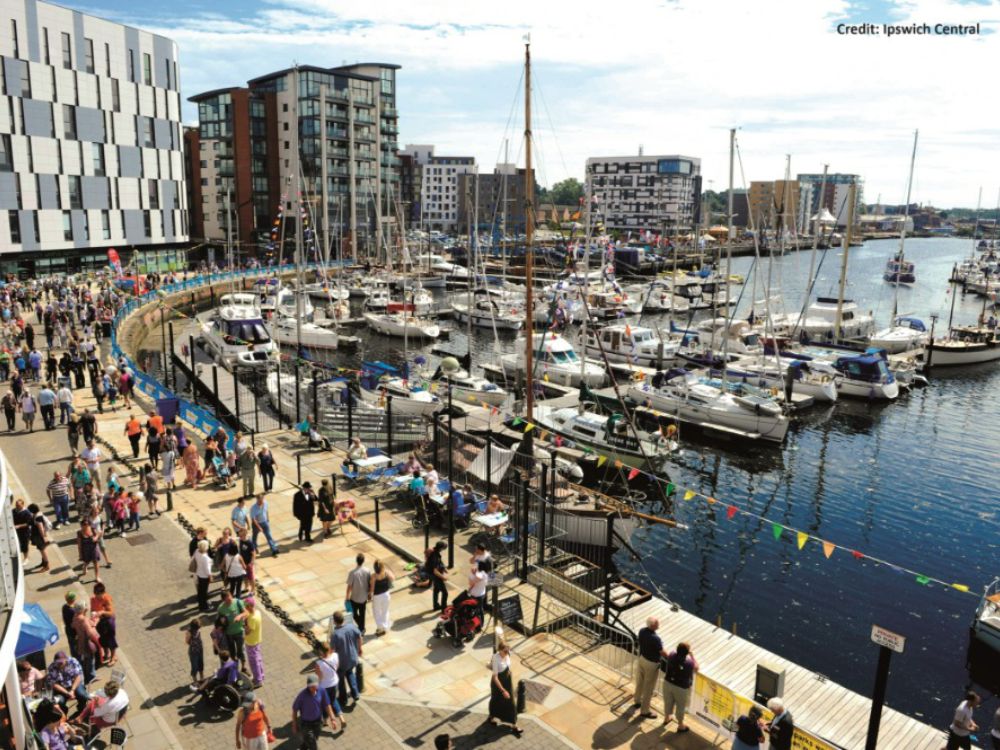


About the Heritage Harbour:
Ipswich’s maritime history stretches back at least as far as Anglo-Saxon times. Since then, it has been at the forefront of our trade with Europe and beyond, an important centre for shipbuilding, and home to several of our national maritime heroes. Its port was heavily used by tall ships, sailing barges and other vessels before, during and after the industrial revolution, and had various important roles during the second world war.
Ipswich’s Heritage Harbour project focuses on the town’s inner harbour, the Wet Dock, home to a vibrant collection of cafes, restaurants and a modern marina, and which also incorporates multiple heritage features which speak to its maritime past. The project is a collaboration between Ipswich Maritime Trust, Ipswich Borough Council, ABP (the port operator) and others.
Maritime Visitor Attractions:
Ipswich’s main Waterfront area faces the Wet Dock, home to over 200 marina berths. There are multiple cafes and restaurants, plus the Old Customs House (built 1845), with the sailing barge Victor moored outside, and a small window museum operated by Ipswich Maritime Trust. Other heritage ships are also frequently visiting or in residence. SB Victor is one of several boats offering cruises down the beautiful Orwell estuary towards Harwich.
Ipswich Museum is currently undergoing major redevelopment. When it reopens in 2025, it will include multiple references to the town’s maritime past. The public exhibition space in The Hold, home of the Suffolk Record Office, close to the Waterfront, frequently contains historic exhibitions. Nearby St Clements, a medieval church and burial site of Sir Thomas Slade, designer of Nelson’s flagship Victory, is currently home to a display of photographs of maritime Ipswich from 1850 to 1950. Nearby too is Wolsey’s Gate, built in 1528 as the river entrance to a major college promoted by Cardinal Wolsey.
In the Past:
Ipswich is England’s oldest continuously inhabited town, established as “Gyppeswyk” by Anglo-Saxon sailor-settlers. It suffered Viking raids, but became one of Britain’s wealthiest early medieval towns, and was a Head Port of the Hanseatic League. It was also a major ship-building centre, benefiting from plentiful oak woods nearby; at one time a large proportion of England’s warships were built on the Orwell.
Notable Ipswich seafarers include: Thomas Cavendish and Thomas Eldred, who first sailed around the world in the 1580s; Bartholomew Gosnold, a founder of Jamestown, our first American colony, in the early 1600s; and leading 18th and 19th century admirals Broke and Vernon, both of whose fine country houses still stand on the banks of the Orwell estuary. Lord Nelson, despite his better-known links with Norfolk, was High Sheriff of Ipswich when he died at Trafalgar in 1805.
Ipswich flourished during and after the industrial revolution; when the Victorians built the Wet Dock in 1842 it was the largest of its kind in the country, attracting over 30 factories and industries, clustered around its quaysides. Thus, “Maritime Ipswich” is directly responsible for the Victorian prosperity still evident today in the many fine buildings included on the town’s List of Buildings of Special Architectural or Historic Interest.
Now and the Future:
Ipswich has retained its maritime significance: Felixstowe, at one end of the Orwell estuary, is the UK’s largest container port, and Ipswich, at the other end, is its largest agricultural export port. However, this large scale commercial activity is mainly well away from Ipswich’s inner harbour, which is the focus of the Heritage Harbour project, and whose marina, with space for both modern and heritage boats, makes an attractive backdrop to the activities on offer on the Waterfront.
Our plans are to build on this appeal, by attracting more heritage vessels both to visit and to stay at the Wet Dock, and creating new museum displays, information boards and heritage walks around the Waterfront. We also want to build on Ipswich Maritime Trust’s existing events programme, to offer new experiences for wider audiences, and to increase the accessibility of the Trust’s collection of 2,500 historic photographs. And we want to launch a Youth Programme, designed to increase opportunities for schoolchildren to learn about our maritime past, and to have on-the-water experiences, and to offer bursaries for young adults seeking to fund life-changing maritime experiences or start a career in related trades.

